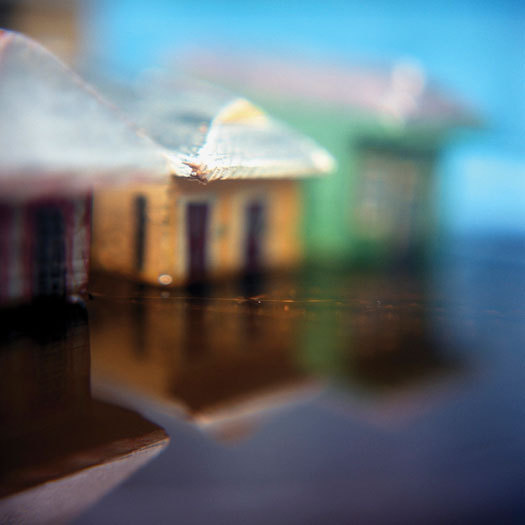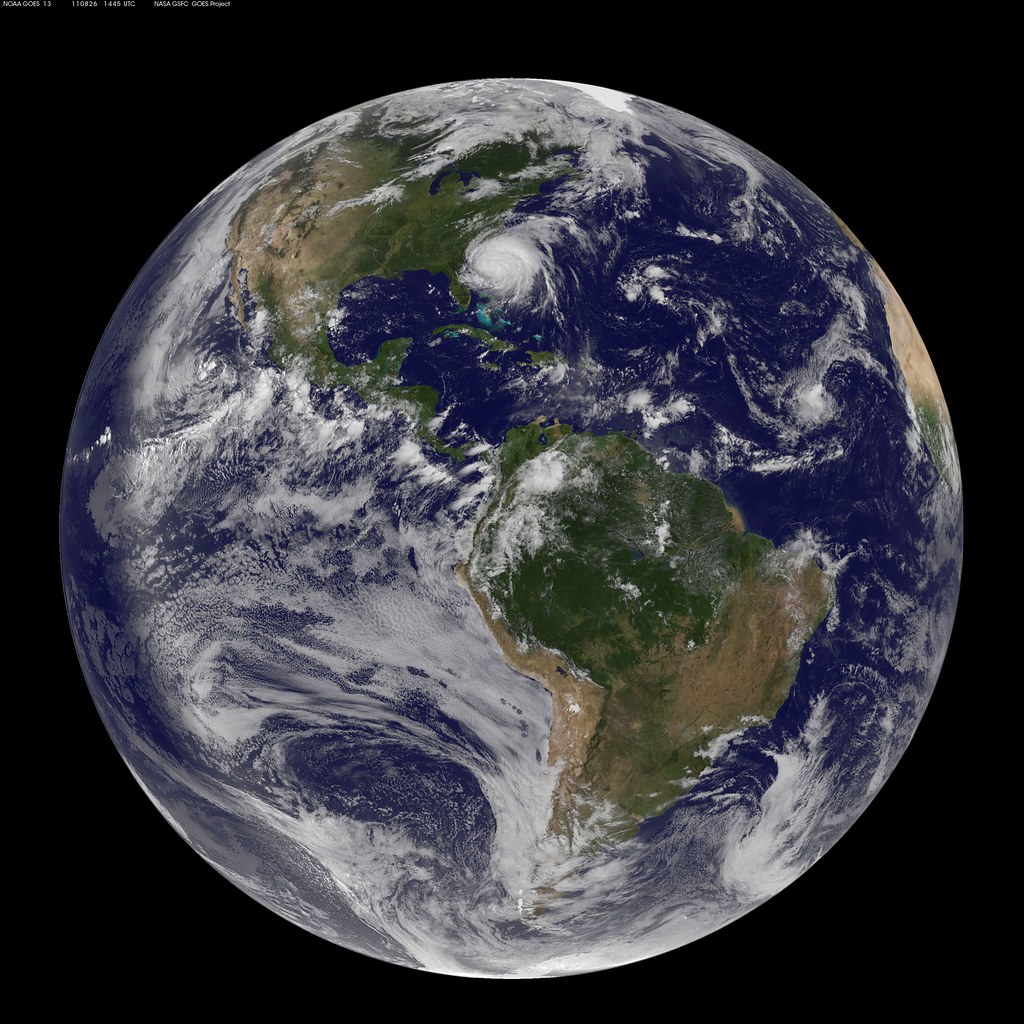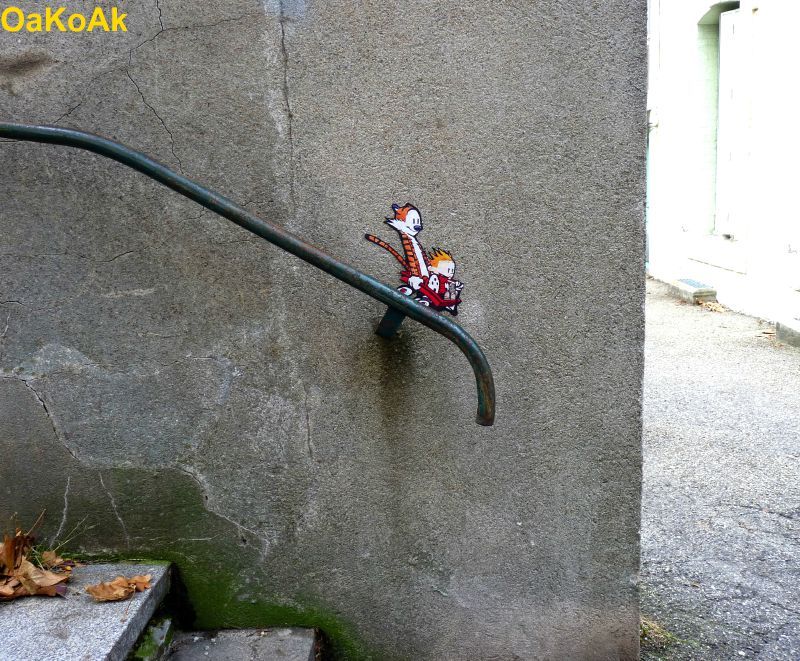One of my favorite photographic blogs is Light Stalking. The blog focuses on the intricacies of lighting your subject well. In this article, using natural light to photograph statues is discussed. I posted this because the statues themselves are beautiful.
37 Statues
Wednesday, August 31, 2011
Tuesday, August 30, 2011
Hurricane Story
Having just gone through hurricane Irene (and very worried that we'd just dropped off our daughter for college on Staten Island), I think it might be good to remember another killer storm, Katrina. Since I've been blogging about photography I continue this theme with a look at a book by Jennifer Shaw. This 46 page book of photos tells the story of how she and her husband fled New Orleans the day before the hurricane hit and their son's birth in Alabama. It is done with toys and shot with a Holga 120 toy camera.
Here's link to her site, Hurricane Story.
Here's link to her site, Hurricane Story.
Monday, August 29, 2011
Sherry Ott
One of my favorite new travel photographers is Sherry Ott. A few years back she got tired of being a corporate cubicle dweller and lit out for the open road. She now seems to be based out of Ulaanbaatar, Mongolia and she's taken some of the most wonderful travel photos I've seen.
At present, she's just gotten home after a road trip; London to Mongolia, 9000 miles, 13 countries, 2 continents in 5 weeks in a little Nissan Almera. And you think you go on vacations.
Here is a link to her website. Enjoy the photos.

At present, she's just gotten home after a road trip; London to Mongolia, 9000 miles, 13 countries, 2 continents in 5 weeks in a little Nissan Almera. And you think you go on vacations.
Here is a link to her website. Enjoy the photos.

Sunday, August 28, 2011
Moving Our Daughter Into College In NYC
If you have children, you hopefully get to see them grow up and go to college. Our youngest, Katharine, has begun that journey at Wagner College on Staten Island. Here is a little photo-essay that chronicles the journey from Virginia to her dorm room.

Here is just one of the many piles of "absolutely necessary" items about to be packed in our two vehicles to make the 240 mile trip.
The packing has begun...
...and continues. Soon both cars will be stuffed full.
Our arrival at the hotel in Staten Island.
And the great blessing of New York style pizza.
The morning of the "move-in." We're about to leave the hotel and drive to her dorm.
The line ahead....
...and behind.
Her dorm....
...and the unbelievable view from her dorm room. You really have to click on this one to appreciate it. She can even see the Statue of Liberty from here. How many of us can say that?
Stuff everywhere...
...and more stuff over there.
On the way to lunch.
You mean I have to WALK everywhere I go?!?
Mom, can you move up here and cook for me?
Finally done! Look out, New York!

Postscript: Hurricane Irene is pounding the college as a I write this, but Katharine and her friend Angie have evacuated to New Jersey and are safe at Angie's house. What an exciting start to the school year!
Saturday, August 27, 2011
The Whole Earth as of Yesterday
Since I've been blogging about photography and the blog was initially inspired by The Whole Earth Catalog, I think a good thing to post today would be an up-to-date photo of the whole earth taken by NASA using the NOAA GOES-13 satellite. It was taken yesterday just before 11am Eastern time. Hurricane Irene can be seen toward the top center just east of Florida.
Puts things in perspective, doesn't it?
Puts things in perspective, doesn't it?
Friday, August 26, 2011
Galen Rowell
I love mountain landscape photography and one of my favorite's is still the late Galen Rowell. Rowell sold his automobile repair business in 1972 and took the money to jump-start his adventures in mountain exploration and photography. He traveled all over Asia, but was especially drawn to Nepal and Tibet. His beautiful shots of mountains and monasteries always fascinated me, but I was especially taken by his photos of the people of the area. His many pictures of Buddhist ordained made me want to travel there. It still does.
He was also a highly regarded writer on subjects ranging from photography, humanitarian and environmental issues, human visual cognition, and mountaineering, publishing numerous magazine articles and eighteen books in his lifetime.
Rowell, his wife Barbara Cushman Rowell, pilot Tom Reid, and Reid's friend Carol McAffee were all killed in a plane crash near the Inyo County Airport in Bishop, California, on August 11, 2002.
Here's a link to his website where you can purchase prints of his work. By the way, the rainbow is real.
He was also a highly regarded writer on subjects ranging from photography, humanitarian and environmental issues, human visual cognition, and mountaineering, publishing numerous magazine articles and eighteen books in his lifetime.
Rowell, his wife Barbara Cushman Rowell, pilot Tom Reid, and Reid's friend Carol McAffee were all killed in a plane crash near the Inyo County Airport in Bishop, California, on August 11, 2002.
Here's a link to his website where you can purchase prints of his work. By the way, the rainbow is real.
Thursday, August 25, 2011
Weegee
Arthur Fellig was known for his stark black and white photos of life on the Lower East side of New York City. His work was an unflinching view of urban life that showed the joys and sorrows of the city he emigrated to as a child and loved. He earned his nickname, a phonetic rendering of the word "ouija" because of his frequent, seemingly prescient arrivals at scenes only minutes after crimes, fires or other emergencies were reported to authorities.
I particularly enjoy his shots of the lives of children in The Big Apple.
Weegee's World
I particularly enjoy his shots of the lives of children in The Big Apple.
Weegee's World
Wednesday, August 24, 2011
Ansel Adams
Of all the great landscape photographers, Ansel Adams stands apart. He was best known for his black and white photographs of the American West, especially Yosemite National Park. So much has been written and said about this great photographer that I'll simply refer the reader to his Wikipedia page for further info.
Here's a link to his website where you can see many more examples of his stunning work.
Here's a link to his website where you can see many more examples of his stunning work.
Tuesday, August 23, 2011
Henri Cartier-Bresson
Henri Cartier-Bresson was one of the great Magnum photographers and along with Robert Capa, David Seymour and George Rodger founded Magnum Photos in the spring of 1947. He was born in France, the eldest child of a wealthy textile manufacturer. He studied oil painting as child, but was later drawn to photography, studying it with his uncle. As an adult he once explained, "I suddenly understood that a photograph could fix eternity in an instant." A full biography is available on his Wikipedia page.
Here is a link to his website's gallery page.
Here is a link to his website's gallery page.
Monday, August 22, 2011
More Great Photos
I'll be blogging about photography and photographers a bit. Here's a site that features some of the best photographic images in existence - MAGNUM PHOTOS. They represent some of the worlds great artists in the field including Henri Cartier-Bresson, Paul Fusco, Steve McCurry, Abbas and Martine Franck. The images that they (it's a co-operative owned by its photographer-members) represent "chronicle the world and interpret its people, events, issues and personalities."
I think the photos speak for themselves.
I think the photos speak for themselves.
Saturday, August 20, 2011
Film Is Not Dead
In a previous life I worked as a photographer and cinematographer. I loved film. I loved that you really had to know what you were doing to get a usable result. You had to understand how film worked. You had to understand light, shadow and an H and D curve.
Now digital photography is the norm. Most of the photographers I knew who were adamant about film in the '80s and '90s have now embraced digital. But in New York City (and elsewhere) there are a group of die-hard filmophiles that refuse to give up using film cameras. This short film features several and the services that support them.
Kodachrome may be gone, but just like buggy whips, film is here to stay.
Now digital photography is the norm. Most of the photographers I knew who were adamant about film in the '80s and '90s have now embraced digital. But in New York City (and elsewhere) there are a group of die-hard filmophiles that refuse to give up using film cameras. This short film features several and the services that support them.
Kodachrome may be gone, but just like buggy whips, film is here to stay.
Friday, August 19, 2011
We Should Listen to Warren Buffett
In America, we revere the rich. We listen when they talk and we follow their advice hoping that some of their wealth will rub off on us. Here is Warren Buffett, arguably one of our nations richest men, telling us that things HAVE to change if we are to avoid disaster. In this video Warren Buffett discusses his New York Times Op-Ed piece 'Stop Coddling the Super-Rich' which calls on Congress to increase taxes on the Super-Rich like himself. He says, "Yes, there's been a class war in the United States. And my class, namely the super rich people, have won."
The question I have is, will we listen?
The question I have is, will we listen?
Thursday, August 18, 2011
Wednesday, August 17, 2011
Where's Your Get Up and Go?
In the "New Economy" being light on your feet will really count. Being able to be mobile for work, play and life will open up opportunities unavailable to those rooted to place. This wonderful video features a 1949 Pullman Railcar that has been converted into a living/working space. It's 85' long by 9½' wide and the interior has been designed by Marc Riera. Now this could sure save you energy, money and take you to where the work is.
Tuesday, August 16, 2011
Hunter Lovins - The Madrone Project
The cost of energy drives the price of everything else. The Madrone Project is a non-profit educational team that brings greater depth and scale to sustainability education by delivering advanced modular curricula curated for digital media. Madrone works with academic institutions, companies and citizens who want high quality education on the challenges facing the planet and the new research developments that will impact the future of sustainability. And the future we want to get to is in the hands on those being educated now.
Watch this TEDx video from Hunter Lovins. She explains that the problem facing energy sustainability is not that it costs more; it's that it costs less. New energy technologies are threatening older, costlier, entrenched technologies and the industries that are supported by them. That's why we're not moving into the future. We're too attached to our past.
We can change this. We can achieve energy independence. We need to educate ourselves and our young people to do this. She will explain how easily this can be done.
Monday, August 15, 2011
Not All Energy Comes From Technology
Energy is tied directly to wealth and lack of affordable energy is tied directly to poverty. Do you think the poor work less hard than you do? Think again. Cheap energy (and being able to leverage that energy to increase productivity) in America has brought us the wealth we enjoy.
Paul Polak's vision is that if you treat the poor like consumers and entrepreneurs, they will get themselves out of poverty. His non-profit company, International Development Enterprises (IDE), is dedicated to developing practical solutions that attack poverty at its roots. It has developed many tools to make this happen and some of them are human and animal powered. These sources of energy are scaled and appropriate to the developing cultures. Polak's work has already moved 17 million people out of poverty. That might be a drop in the bucket, but it's a good start.
Have a look at his video from TEDxTalks and check out his book, Out of Poverty.
Paul Polak's vision is that if you treat the poor like consumers and entrepreneurs, they will get themselves out of poverty. His non-profit company, International Development Enterprises (IDE), is dedicated to developing practical solutions that attack poverty at its roots. It has developed many tools to make this happen and some of them are human and animal powered. These sources of energy are scaled and appropriate to the developing cultures. Polak's work has already moved 17 million people out of poverty. That might be a drop in the bucket, but it's a good start.
Have a look at his video from TEDxTalks and check out his book, Out of Poverty.
Sunday, August 14, 2011
Let There Be Light!
We waste energy. There's no doubt about it. We especially waste it making light. 1.4 billion people around the world don't have access to an electrical grid. In many parts of the world, when the sun goes down, that's the end of the day. Getting light into rural areas of the developing world usually involves burning kerosene, which is costly, dirty and can also be unhealthy.
Steve Katsaros has a solution. His company Nokero (short for "No Kerosene"), set out to get light into as many hands as possible in the developing world. The Nokero N200 is his creation.
It's great for camping, too. I think I'm going to get several.
Steve Katsaros has a solution. His company Nokero (short for "No Kerosene"), set out to get light into as many hands as possible in the developing world. The Nokero N200 is his creation.
It's great for camping, too. I think I'm going to get several.
Saturday, August 13, 2011
The End Of Gasoline
I think I'll do a few blog entries on energy now.
Everywhere you look you see the end of oil as an energy source. One of the main indicators is higher prices for things because of higher energy costs. So much talk about peak oil, drill-baby-drill and other such nonsense.
Well the end of oil appears to be just around the corner. Researchers have discovered a great alternative solution to gasoline: 1 gram of thorium can produce the equivalent energy of 7,500 gallons of gasoline.
Here are two articles that discuss the subject. The first is about the research and technology behind this and the second concerns the experimental vehicle designed to use this breakthrough.
Ain't tech grand?
8 Grams of Thorium Could Replace Gasoline in Cars
U.S. Researcher Preparing Prototype Cars Powered by Heavy-Metal Thorium
Everywhere you look you see the end of oil as an energy source. One of the main indicators is higher prices for things because of higher energy costs. So much talk about peak oil, drill-baby-drill and other such nonsense.
Well the end of oil appears to be just around the corner. Researchers have discovered a great alternative solution to gasoline: 1 gram of thorium can produce the equivalent energy of 7,500 gallons of gasoline.
Here are two articles that discuss the subject. The first is about the research and technology behind this and the second concerns the experimental vehicle designed to use this breakthrough.
Ain't tech grand?
8 Grams of Thorium Could Replace Gasoline in Cars
U.S. Researcher Preparing Prototype Cars Powered by Heavy-Metal Thorium
Thursday, August 11, 2011
Fun Break!
I love Monty Python. I love Terry Gilliam. I love animation.
Here's how you do it.................................................................
Here's how you do it.................................................................
Wednesday, August 10, 2011
Whatcha' Got?
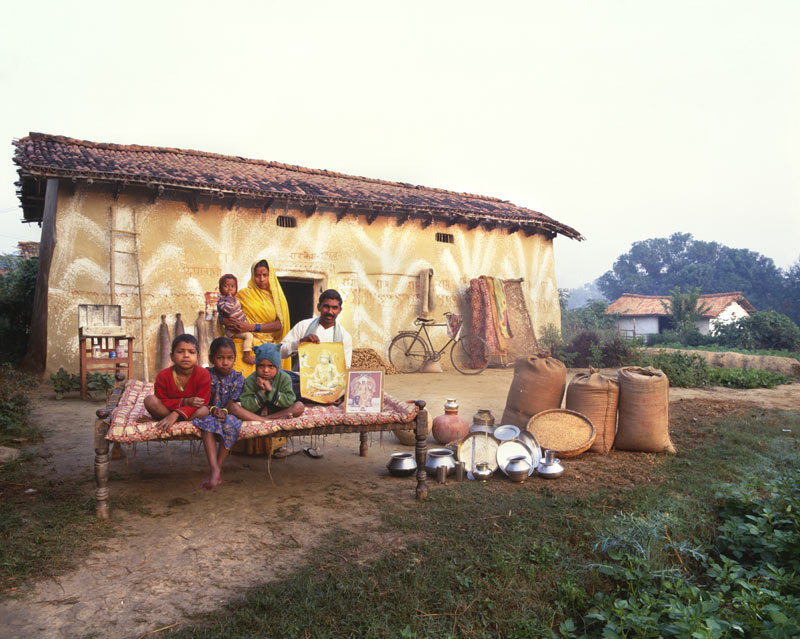 |
| photo: Peter Ginter |
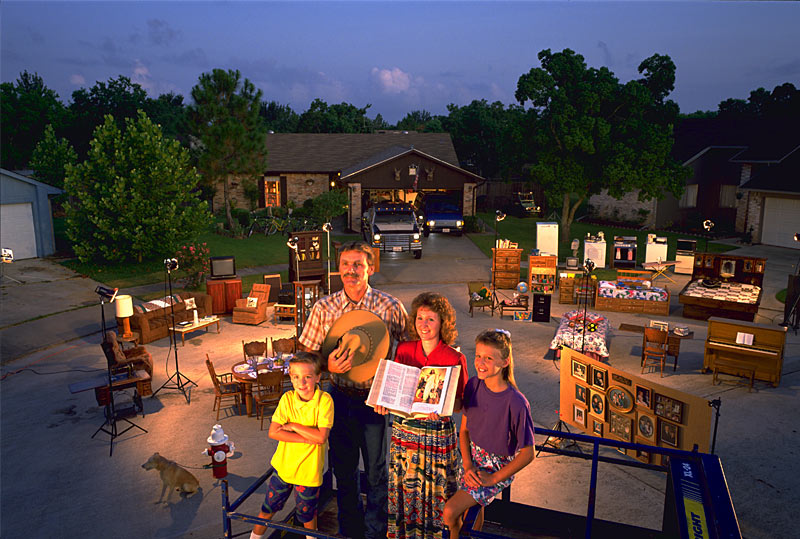 |
| photo: Peter Menzel |
Perspective.
Tuesday, August 9, 2011
Recession Special: Home & Workplace In Ten Feet By Forty
I saw this on a blog last August and filed it for later use. Following the current theme of this blog and with economic reality hitting so many of us squarely in the face these days, I think it might be a good time to post it now.
Michael Pozner was living in a little less than 500 square feet when he decided that he was going to optimize the space he had for maximum use. This is the result. This makes a lot of sense for high density, urban living such as his location, New York City. It also makes sense for any environment where space is at a premium. I especially like the pull-out stairs as drawers.
Michael Pozner was living in a little less than 500 square feet when he decided that he was going to optimize the space he had for maximum use. This is the result. This makes a lot of sense for high density, urban living such as his location, New York City. It also makes sense for any environment where space is at a premium. I especially like the pull-out stairs as drawers.
Monday, August 8, 2011
Backyard Solutions To Urban Planning Issues
My guess is that as we continue to experience economic downsizing in this country, we, as a practical people (as opposed to our "leaders") will turn to a number of ways to get back on our feet.
This small, orange-colored home was built in the backyard of Karen Chapple, a University of California, Berkeley, associate professor of city and regional planning and faculty director of the Center for Community Innovation. She is heading a study funded by the UC Transportation Center to determine how many of these accessory homes could be built around five Bay Area Rapid Transit stations in the East Bay, and how they might affect the local economy.
Imagine if urban areas around the country adopted ideas like this, not only placing small, affordable housing near mass transportation, but also work. Think of all the energy, gasoline, money we'd save. Think of the communities we could build.
Berkeley Institute of Ubran and Regional Development
Saturday, August 6, 2011
More On The Future Of Cities
Here's a follow-up article from Stewart Brand concerning slums and their contribution to the vibrancy of urban life. It is interesting to note that New York City was surrounded by slums about 150 years ago. Look how that turned out.
How Slums Can Save The Planet
How Slums Can Save The Planet
Friday, August 5, 2011
Where We'll Live In The Future
I am fascinated by cities. I grew up in a rural place. There were farms all around me during my childhood. Cities were a place of wonder. I saw them on television and they were distant, gleaming and alluring. When I was nine, I went to the World's Fair in NYC and I was forever changed by what I saw. Rural life just didn't cut it after that.
In my twenties I went to live in Boston, Massachusetts and got to see first hand what city life was really like. As with anything there was good and bad, expectations met and disappointments. But I'll never forget how exhilarating it was. I still miss Harvard Square a lot.
One of my favorite thinkers, Stewart Brand, had a wonderful talk at TED a few years ago about how the rural areas of the developing world were emptying out and the people moving to the cities and how this would start a second economic, social and technological revolution. The talk below by Geoffrey West at TEDGlobal extends this idea and shows how the properties of cities - wealth, crime rate, walking speed and many other aspects can be deduced from a single number: the city's population.
In my twenties I went to live in Boston, Massachusetts and got to see first hand what city life was really like. As with anything there was good and bad, expectations met and disappointments. But I'll never forget how exhilarating it was. I still miss Harvard Square a lot.
One of my favorite thinkers, Stewart Brand, had a wonderful talk at TED a few years ago about how the rural areas of the developing world were emptying out and the people moving to the cities and how this would start a second economic, social and technological revolution. The talk below by Geoffrey West at TEDGlobal extends this idea and shows how the properties of cities - wealth, crime rate, walking speed and many other aspects can be deduced from a single number: the city's population.
Thursday, August 4, 2011
Wednesday, August 3, 2011
How About This?
Could be our future they're looking at. Check out this New York Times article on the Dutch and tell me what you think.
The Dutch Way: Bicycles and Fresh Bread
The Dutch Way: Bicycles and Fresh Bread
Tuesday, August 2, 2011
Open Source Civilization Kit
With the current political debacle threatening to undermine our economy, we should, once again, be concerned with going it "on our own." I don't mean running into the woods with a gun and tent and a gallon jug of water. I mean that we should figure just what it takes to maintain a civilized standard of living and then do something substantive about insuring that those things get done. Leave the squabbling to those better suited to do it in Washington. That's why they go there, not to help us.
Marcin Jakubowski has a Ph. D. in fusion physics and is a TED 2011 Fellow. He is in the process of developing a toolkit of "50 different Industrial Machines that it takes to build a small civilization with modern comforts," called the Global Village Construction Set. It includes everything from a tractor to a 3-D printer, pieced together with interchangeable parts, motors and power units as if it were a "life-sized lego set." They currently have eight prototypes available on their Wiki, complete with designs, how-to videos for assembly, and budgets. His group, Open Source Ecology, wants the kit to lower "the barriers to entry into farming, building, and manufacturing" for the DIY community, and even extend their ideas for use in the developing world.
Here's a video of his group's project.
Here's a link to Jakubowski's four minute TED talk from 2011.
Marcin Jakubowski has a Ph. D. in fusion physics and is a TED 2011 Fellow. He is in the process of developing a toolkit of "50 different Industrial Machines that it takes to build a small civilization with modern comforts," called the Global Village Construction Set. It includes everything from a tractor to a 3-D printer, pieced together with interchangeable parts, motors and power units as if it were a "life-sized lego set." They currently have eight prototypes available on their Wiki, complete with designs, how-to videos for assembly, and budgets. His group, Open Source Ecology, wants the kit to lower "the barriers to entry into farming, building, and manufacturing" for the DIY community, and even extend their ideas for use in the developing world.
Here's a video of his group's project.
Here's a link to Jakubowski's four minute TED talk from 2011.
Monday, August 1, 2011
Is This Where We're Headed?
What with all the apocalyptic talk about the debt ceiling and political gridlock, I thought it might be a good idea to take a look at what happens when you can't pay your bills. This article highlights Detroit's lack of grocery stores and how folks are coping. Have a look. It's called Forget Urban Farms. We Need a Wal-Mart.
Subscribe to:
Posts (Atom)


